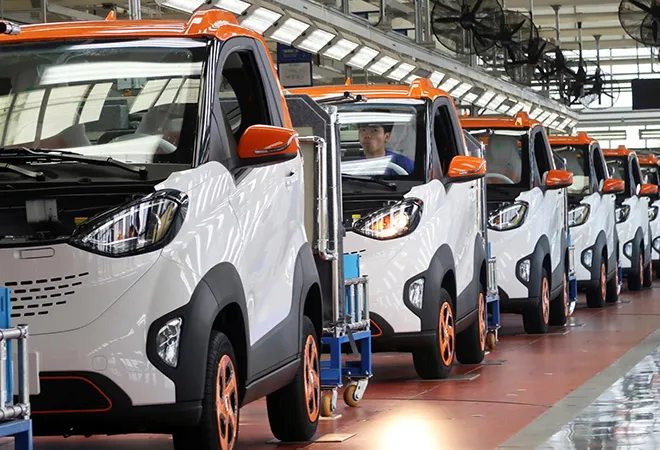 This is the 91st article in the series
This is the 91st article in the series The China Chronicles.
Read the articles here.
Electric Vehicles (EVs) are poised to take center stage in the impending transformation of the automobile sector into a renewable alternative as opposed to fuel dependent vehicles. The Indian government has responded accordingly, shelling out a significant outlay under the Phase II of Faster Adoption and Manufacturing of (Hybrid &) Electric Vehicles in India (FAME India) scheme. Along similar lines, the recent governmental push for thirty percent EVs on-road by 2030 is arguably one of the most ambitious energy transformation projects undertaken. This scheme primarily aims to address the concentration of vehicular emissions in cities by reducing the number of fuel run Internal Combustion Engine (ICEs) vehicles to rechargeable EVs. NITI Aayog believes that Indian fuel import, which covers eighty percent of the import bill, can also be drastically reduced saving as much as USD 60 billion by 2030. Due to a high number of polluted cities, such adoption of advanced green technology and employment of efficient battery chemistries worldwide could not have happened at a better time. Although the EV transition is imminent with the central government and twelve state governments have already bet big on this transition, it is significantly dependent on factors beyond India’s control.
The Indian EV sector is reliant on internal and external factors to catalyze this transition. Internal factors are phase-wise planning, governmental support, robust financing, battery manufacture, incubation of an innovation ecosystem and setting up local infrastructure. The external factors that determine India’s bid to “global leadership” are geopolitical complexities of resource procurement, global supply chains for technological expertise and the technology itself. While EVs are predicted to limit vulnerability from oil supply disruptions, a new trend of lithium-ion dependency is bound to emerge. Lithium-ion run batteries (LIBs) are the driving cost of EVs, rendering lithium and other rare earth metals valuable commodities, and high-performance batteries even more costly. India is dependent on the global supply chain for these resources and high-end technology, which is currently championed by the People’s Republic of China (PRC). The PRC by a significant margin has the biggest market in the EV sector.
China began electrification of its vehicles in 2010 with emphasis on subsidizing short-range batteries initially (these subsidies are not operational anymore). The current subsidies for long-range batteries enable China to leverage incentives to climb the technology value chain further. This makes China the biggest market for EVs since the announcement of their 13th Five Year Plan, which boosted projects to extract lithium (multiple projects are currently in the pipeline). China’s EV boom can be attributed to the battery hub it has become over the decade. This has not only enabled China to become the key supplier of lithium and cobalt, it has also allowed China to make advancement in the battery technology, subsequently reducing their EV costs. India does not have much to show in terms of an EV ecosystem and needs to ensure business viability in a ‘price sensitive’ market. Like China, the Indian market is also dominated by two-wheelers, and both EV polices envision commercial and public transport as inception point for automobile electrification. Introduction of EVs in the two-wheeler segment has provided a resilient backbone to the Sino automobile industry by employing it for private as well as “last and first mile solutions”. India has similar plans for their three-wheeler and two-wheeler segments.
To catalyze a widespread EV transition and generate demand, China is expected to play a huge role in India’s realization to the EV dream. Infact, China is already playing a historic role in India’s battery manufacture industry. Chennai-based Munoth Industries has taken a gigantic leap to set-up a Li-ion cell manufacture unit with the help of Better Power Company, a China-based firm, (at a plant in Tirupati, Andhra Pradesh). With an investment of INR ₹799 crore, it will be first of its kind in the country and will generate employment for approximately 1,700 people. Under the first phase, targeted capacity is of 250MW (which will translate into about twenty lakh 3AH lithium batteries) with an expected increase of five times in three years under phase two.
India is primarily dependent on China, Taiwan and Japan for import of lithium cells with the assembling (cell to pack) taking place in India. From only assembling the Lithium Ion Batteries (LIBs), India now plans to manufacture and prioritize better battery chemistries accustomed to Indian roads as opposed to importing batteries that significantly increase the cost of an EV. Importing an entire LIB is costlier due to factors like increased custom duty, rupee depreciation, high demand, and transportation cost. Imported batteries have been reported to dispose inferior output with significant deterioration being reported in the battery capacity and longer charging hours over the course of a few years. A widely held fear is that India is becoming a dumping ground for low quality Chinese batteries. Importing cells is considered a reason for the depreciation of the quality and quantity of EVs on Indian roads, resulting in the cost of an EV being much more than a combustion engine vehicle. The reason to indigenize LIB manufacturing is two-fold as it benefits the manufacturers and the consumers alike. First, it will drastically bring down the cost of ownership of an EV; it will also create demand, mitigate price shock and subsequently reduce consumer reluctance towards EVs. Second, it will reduce inter-dependence on other states, reduce susceptibility from substandard batteries, value generation in the country and incubate technical expertise. Recent policies for the domestic battery manufacture initiative gained traction amongst battery giants like Tesla, China’s Contemporary Amperex Technology Co. Ltd (CATL) and BYD Co. Ltd showing interest in the Indian market.
While the abovementioned reasons to indigenize LIB manufacture stands accurate, Chinese companies can still offer multifarious advantages to a young EV market like India. Key constituents to LIBs are lithium, cobalt, nickel, manganese and natural graphite. While the latter three battery materials are relatively omnipresent, it is the occurrence of lithium and cobalt that casts a huge doubt on the international and local EV manufacturers. However, the main issue does not arise from lack of resources but due to a supply-demand gap, since these resources are concentrated in certain geographies. Concentration of Cobalt and Lithium in Democratic Republic of Congo and the South American Lithium Triangle due to domestic instability. Furthermore, the enrichment and supply chain of both resources is monopolized by China. This makes the EV market susceptible to geopolitical risks caused by governmental policy, climate change; manufacturing decline or socio-political instability exacerbating price uncertainty and volatility. For example, Cobalt’s concentration in DRC can cause supply disruptions and can lead to short-term supply gaps, as was the case in the 1970s due to political unrest in the country temporarily halting the exports significantly. The trade network for Cobalt is dominated by two countries – the DRC and China. China is the leading producer as well as importer of Cobalt (1.2 billion of 3.1 billion global trade value) in the years 2015 and 2016. China was the leading consumer for cobalt using 80% of the Cobalt for the rechargeable battery industry.
Another important facet of the Chinese EV ecosystem is that it can generate a positive impact on the Indian market if the government can selectively adopt certain best practices, like China’s creation of a sustainable battery value chain. Although, China dominates the current LIB market, Beijing has preemptively addressed challenges of uninterrupted lithium supply and ecological degradation by codifying legislation to make carmakers responsible for recycling batteries. This has provided the LIB manufacturers a circular economic model wherein, post usage, the carbon footprint can now be minimized.
Fostering better engagement with Chinese EV giants is imperative. The race for an automobile leadership will be won in the decades to come but Indian policy must reflect necessary relaxation and promote the EV sector amongst commuters. It remains to be seen how Indian EVs fate will unfold but the Chinese electrification experience holds some promise.
The views expressed above belong to the author(s). ORF research and analyses now available on Telegram! Click here to access our curated content — blogs, longforms and interviews.



 This is the 91st article in the series The China Chronicles.
Read the articles
This is the 91st article in the series The China Chronicles.
Read the articles  PREV
PREV


